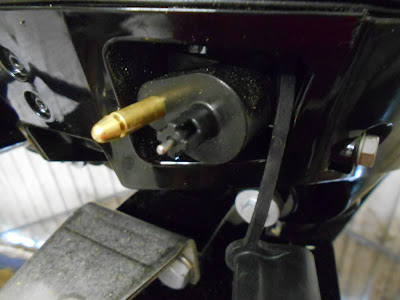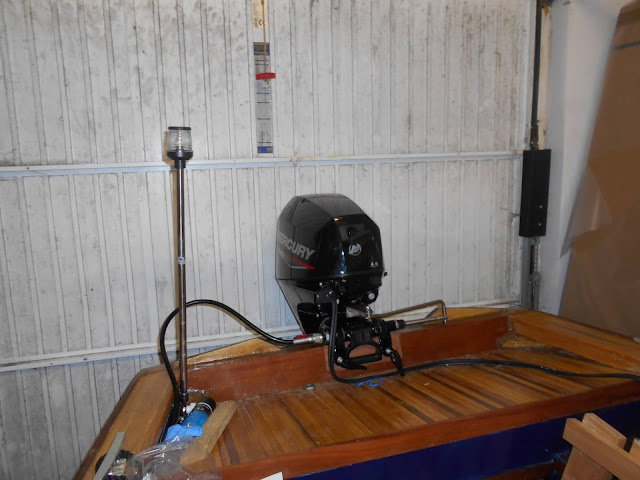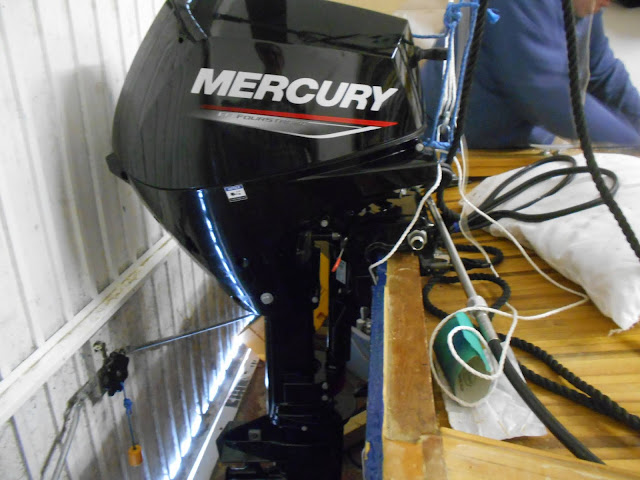I have given Seagull to who live nearby on a farm. I know she has found a good home. So this is me signing off ...... onwards and upwards!!
Project - FISHWALL
The Journal of the build of 'Seagull'
Sunday, 28 July 2024
Tuesday, 11 October 2022
Sunday, 29 August 2021
EVEN M O R E.... Things I needed to know about Outboards, but didn't know I needed to know!!
I wasn't at all sure how I was supposed to start the engine from the control console. I guessed I needed to buy an electrical ignition device, as nothing had arrived with the motor. However, I had ordered a throttle lever that 'fitted all Mercury outboards', and when it arrived I saw that it had an ignition key and electrical cables as part of the assembly.,
When I tried to work out how the electrical ignition cables fitted into the engine I was at a loss, and decided to call my outboard supplier. The conversation went something like this:
"That remote control I bought from you won't fit."
"I know, it's the wrong type, why did you buy it?"
"Because it said it fits all Mercury-"
"No, why did you buy it and not use the one that came with the motor?"
"There wasn't one with the motor!"
"Are you sure?"
"Well I wouldn't have bought another ..."
"True, you'll get it tomorrow."
And I did.
The large cable running from the right in the picture, was run under the starboard gunwale and the 14 pin harness at its end, emerged through the hole in the aft deck.
I then removed the top and starboard cowl from the motor to give me access to the engine itself. I pulled the cable up through the hole in the deck and after a struggle, turned it through ninety degrees and attached it to the turquoise 'female' harness 14 point
The front control console ignition was now connected to the engine. In theory the engine fires when I turn the ignition key - using electricity from the new starter battery.
Sunday, 22 August 2021
M O R E.... Things I needed to know about Outboards, but didn't know I needed to know!!
Many years ago, I took the family to Cornwall and we hired 'Old Stan's Cottage' on the quay of the Cothele Estate, on the River Tamar. We had a little dinghy that came with the cottage and it had a tiny outboard motor which had a little petrol tank on top of it. I assumed all outboards were the same, and I was wrong.
It was hard not to notice that a big red petrol tank came with the motor... it was portable!
The problem was compounded when I couldn't find any sort of inlet for petrol to get into the engine. I read the manual and found only one reference, under the start-up sequence: 'Ensure fuel pipe snaps onto engine fuel inlet'. After looking at every photograph in the book I found one from which I could vaguely see the approximate area the fuel pipe met the engine.
I looked at the end of the fuel pipe and the valve for connecting it to the engine. It made no sense for at the end of the pipe valve was a brass plate and a 'snap hook' thingy.
Looking at the engine in the area I thought might be the right place I found a rubber bung sort of thing, which I pulled off to expose what looked an electrical connection!
I pushed my petrol pipe onto the 'electrical' connection and......'Snap' .... it was in place.
Happy smiling moment, I had learnt something. However, the next thing that had bothered me was how we would get electricity to the engine. This was self-resolving as coming out of the motor were two heavy duty battery wires. Battery wires black and fuel light grey (below)
My next job was to connect the new starter battery to the engine via the battery cables. I began by drilling a large hole in the upper aft deck and feeding both the battery cables and petrol pump through them.
Next I drilled holes through the aft bulkhead of the port locker and feeding the battery wires through the hole
I then unboxed the new battery and placed it in the port. aft, locker.
It seems that the motor will charge the battery much in the same way that car charges its battery. Which solved another problem for me.
It only remained to put two stainless steel bolts through the engine fixing bracket and the transom.
Things I needed to know about Outboards, but didn't know I needed to know!!
I knew the motor would hang off the transom and that it would need to be connected to controls in the wheel house, as effectively the engine also acted as a rudder. That sort of thing is obvious but where and how to start?
You may recall (see March 2020) that I wasn't sure if the steering cable would be long enough to fit into the engine (see fig 1)
 |
| (fig 1) |
When I hung the motor from the transom I could see the cable was between 6 and 8 inches too short. No good having recriminations, so I shopped around for a new cable; no luck, all too short or far too long. There was nothing for it other than to buy a total system.
I removed the old helm mechanism and cable with a bit of difficulty, but nothing like the difficulty I encountered when fitting the new one. I'll not bore you with the details as helm installation was covered earlier... this was much the same but with swearing, blood, tears.
The new cable was just right, you can see it emerging in the bottom right hand corner of the picture with a silver nut and long bar leading into the engine
The long silver bar has to pass through a steel tube on the engine. Before we tried that we have to cover the silver bar in a thick coating of a special grease.
One end of the connecting rod was bolted to the engine steering bracket and the other end bolted to the steering rod via a hole in the rod. All was tightened ready for testing.
I turned the helm from side to side and the engine moved accordingly, hence the engine acted as a rudder.
Saturday, 7 August 2021
Installing the Outboard Motor
Putting the engine into the boat was always going to be a problem: it was so heavy that I couldn't budge it an inch.
Saturday, 24 July 2021
Time For the Power Unit - Meet Mercury
I have fallen behind with my posts on here, concerning the installation of the 'electrics'. Events have overtaken me as the new, American built, Mercury Outboard Motor has arrived.
As is usual, I am totally at a loss with what to do with the engine. I have no experience of installing one, which presents me with the type of impossible challenge I love.
The challenges, however, had began much earlier, when I telephoned my preferred supplier to purchase a specific type of outboard.
"We are out of stock of that model," the supplier said.
"How long before you can get me one?" I asked.
"Could be 12 months".
"What! What else have you got?"
"We are out of stock of everything. Covid closed the factories last year, and they are only just getting back into production. There's a long waiting list, do you want to go on it?"
"I suppose so."
"It's a 20% deposit - "
"No thanks!"
I telephoned around, and got the same story.
Undaunted, I told my story to my facebook boat-group, on which I try to moderate18000 from all around the world. Amongst all the teasing from the pure-sail fans I got one suggestion, to contact 'Cambridge Outboards Ltd.' So I did.
It was out of hours but I could see on their website that they had in stock a Mercury 15 Horse Power, long shaft, 4 cylinder outboard. Just the job! I ordered and 'Paypalled' it........... but got no acknowledgement in my email... panic, panic.
I rang them up first thing Wednesday morning and they assured me all was well and that I should get the motor on the following Monday or Tuesday. So you can imagine my surprise when my front door bell rang on Friday morning and a little lady announced that she was here with the motor, but couldn't get her lorry down the road. There were some builders who had parked their vans on either side of the road and the large lorry couldn't get through.
We couldn't find the builders and the very kind lady and I trolley-jacked a massive heavy box down the middle of the road. Neither of us were very tall so we must have presented an amusing spectacle. By the time we had pushed it up the steep driveway we were all but exhausted What a star she was.
I now had the problem of getting the motor out of its box and into the garage. Then, right on cue, David turned up. David is my daughter's next door neighbour on the farm where they live. He is Polish and his wife, Ula, helps us by doing our cleaning. David was here to cut the back hedge for me (wonderful couple).
David bent down and picked up the motor in his arms!!! It had taken two of us and a trolley jack... but... David picked it up and carried it into the garage where he lay it on some boxes. I met two remarkable people that morning and felt blessed.
Now begins the saga of the installation.































